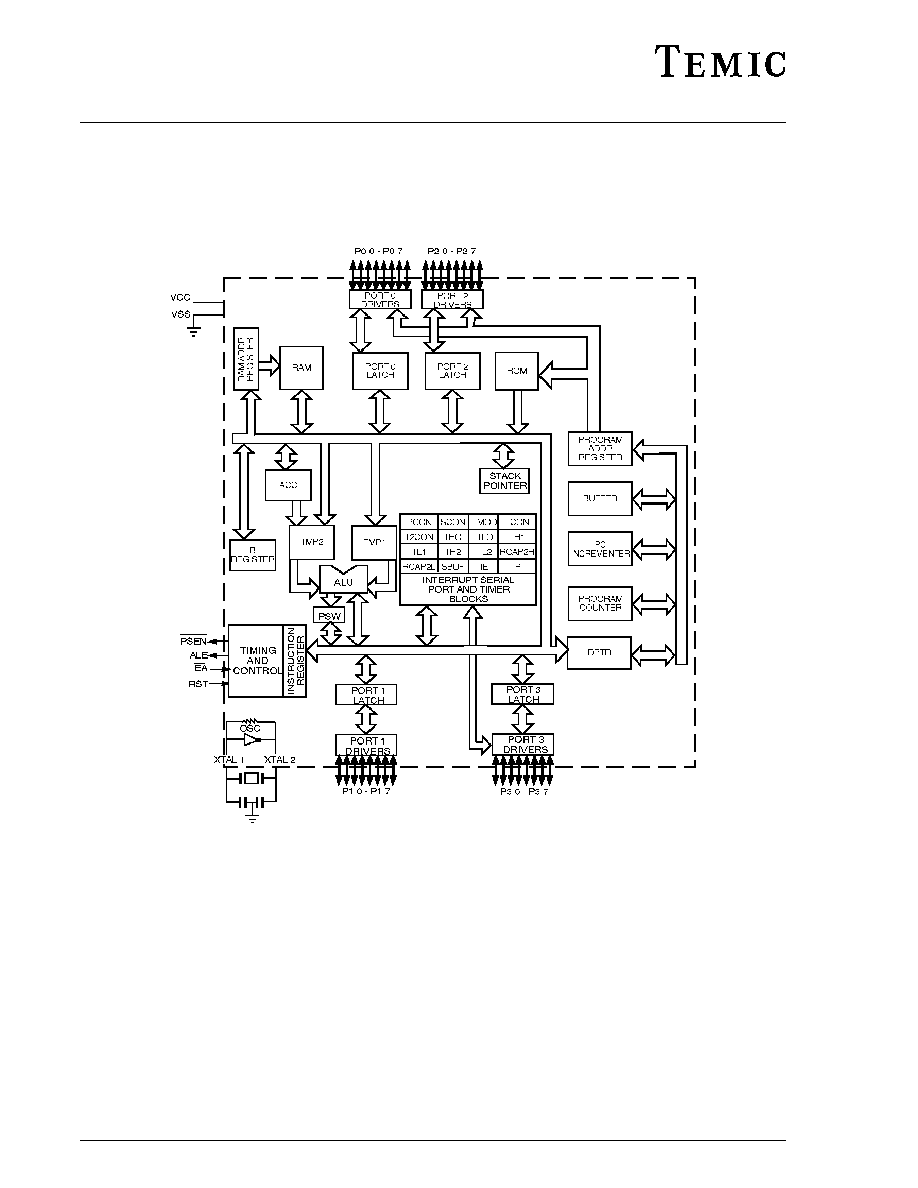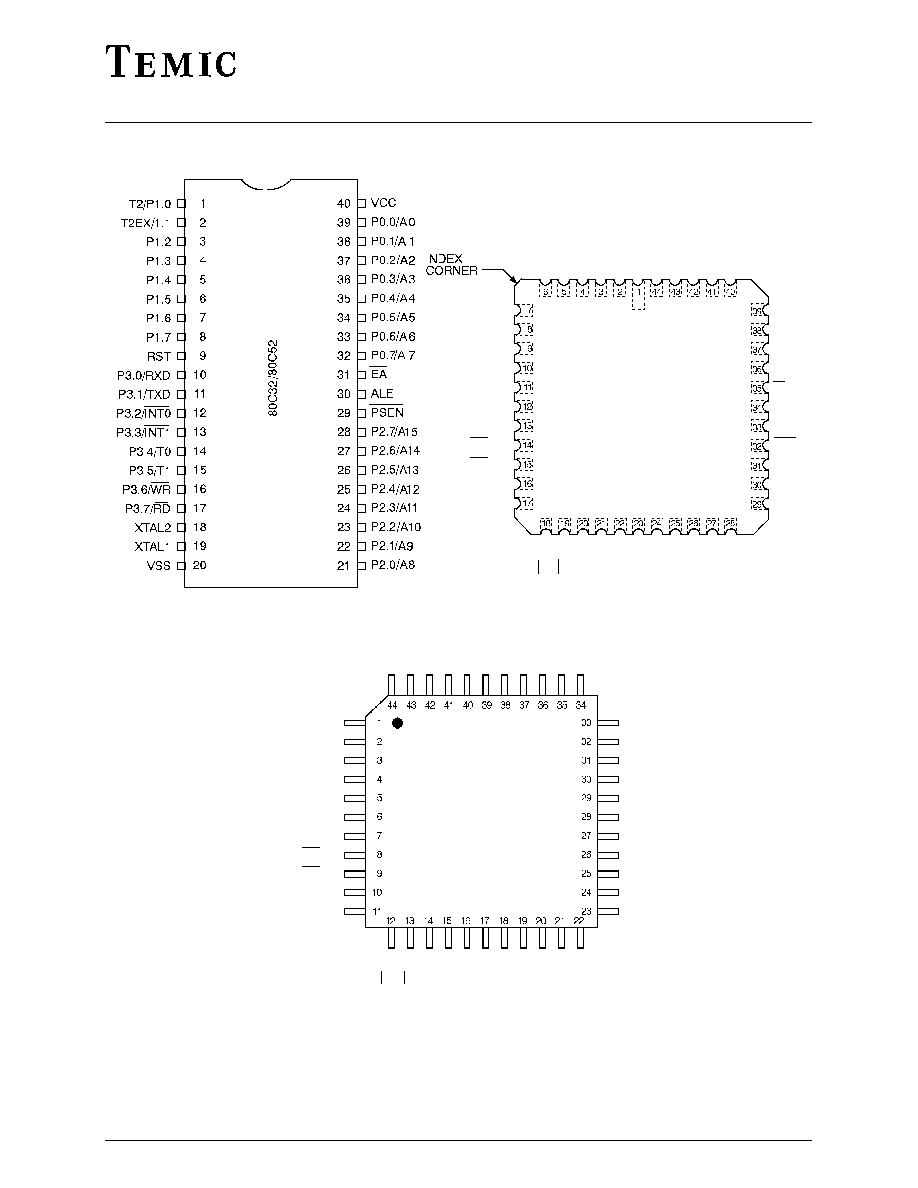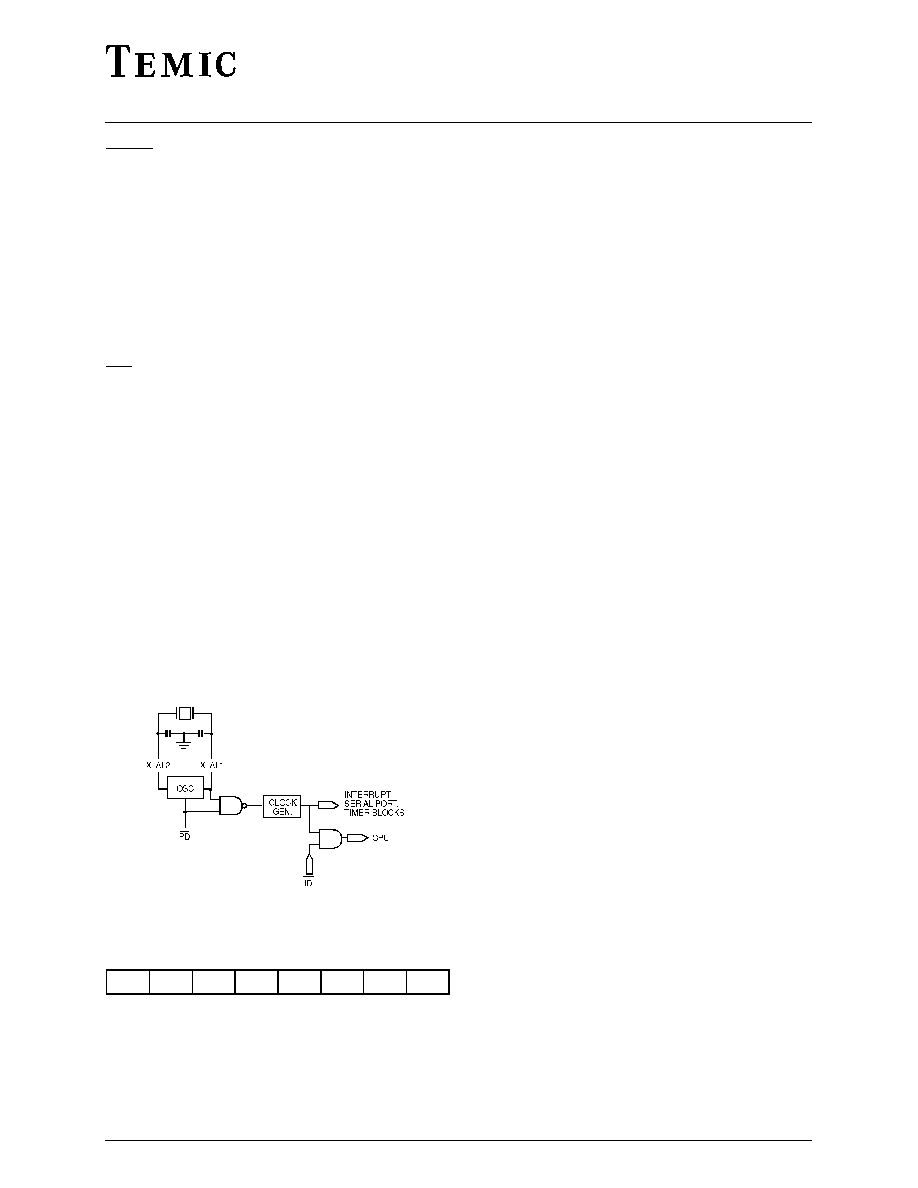 | –≠–ª–µ–∫—Ç—Ä–æ–Ω–Ω—ã–π –∫–æ–º–ø–æ–Ω–µ–Ω—Ç: 80C32-12D | –°–∫–∞—á–∞—Ç—å:  PDF PDF  ZIP ZIP |

80C32/80C52
MATRA MHS
Rev. E (31/08/95)
1
Description
MHS's 80C52 and 80C32 are high performance CMOS
versions of the 8052/8032 NMOS single chip 8 bit
µ
C.
The fully static design of the MHS 80C52/80C32 allows
to reduce system power consumption by bringing the
clock frequency down to any value, even DC, without loss
of data.
The 80C52 retains all the features of the 8052 : 8 K bytes
of ROM ; 256 bytes of RAM ; 32 I/O lines ; three 16 bit
timers ; a 6-source, 2-level interrupt structure ; a full
duplex serial port ; and on-chip oscillator and clock
circuits. In addition, the 80C52 has 2 software-selectable
modes of reduced activity for further reduction in power
consumption. In the idle mode the CPU is frozen while
the RAM, the timers, the serial port and the interrupt
system continue to function. In the power down mode the
RAM is saved and all other functions are inoperative.
The 80C32 is identical to the 80C52 except that it has no
on-chip ROM. MHS's 80C52/80C32 are manufactured
using SCMOS process which allows them to run from 0
up to 44 MHz with Vcc = 5 V.
MHS's 80C52 and 80C32 are also available at 16 MHz
with 2.7 V < V
CC
< 5.5 V.
D 80C32 : Romless version of the 80C52
D 80C32/80C52-L16 : Low power version
Vcc : 2.7 ≠ 5.5 V
Freq : 0-16 MHz
D 80C32/80C52-12 : 0 to 12 MHz
D 80C32/80C52-16 : 0 to 16 MHz
D 80C32/80C52-20 : 0 to 20 MHz
D 80C32/80C52-25 : 0 to 25 MHz
D 80C32/80C52-30 : 0 to 30 MHz
D 80C32/80C52-36 : 0 to 36 MHz
D 80C32-40 : 0 to 40 MHz*
D 80C32-42 : 0 to 42 MHz*
D 80C32-44 : 0 to 44 MHz*
* 0 to 70
∞
C temperature range.
For other speed and temperature range availability please consult your
sales office.
Features
D Power control modes
D 256 bytes of RAM
D 8 Kbytes of ROM (80C52)
D 32 programmable I/O lines
D Three 16 bit timer/counters
D 64 K program memory space
D 64 K data memory space
D Fully static design
D 0.8
µ
CMOS process
D Boolean processor
D 6 interrupt sources
D Programmable serial port
D Temperature range : commercial, industrial, automotive,
military
Optional
D Secret ROM : Encryption
D Secret TAG : Identification number
CMOS 0 to 44 MHz Single-chip 8 Bit Microcontroller

80C32/80C52
MATRA MHS
Rev. E (31/08/95)
2
Interface
Figure 1. Block Diagram

80C32/80C52
MATRA MHS
Rev. E (31/08/95)
3
Figure 2. Pin Configuration
80C32/80C52
80C32/80C52
Diagrams are for reference only. Package sizes are not to scale.
DIL
LCC
Flat Pack
P1.4
P1.3
P1.2
P1.1/T2EX
P1.0/T2
NC
VCC
P0.0/A0
P0.1/A1
P0.2/A2
P0.3/A3
P0.4/A4
P1.5
P1.6
P1.7
RST
RxD/P3.0
NC
TxD/P3.1
INT0/P3.2
INT1/P3.3
T0/P3.4
T1/P3.5
P0.5/A5
P0.6/A6
P0.7/A7
EA
NC
ALE
PSEN
P2.7/A14
P2.6/A13
P2.5/A12
WR/P3.6
RD/P3.7
XT
AL2
XT
AL1
VSS
NC
P2.0/A7
P2.1/A8
P2.2/A9
P2.3/A10
P2.4/A1
1
15
P
16
P
17
P
30
RxD/P
31
TxD/P
32
INT0/P
33
INT1/P
34
T0/P
35
T1/P
36
WR/P
37
RD/P
XT
AL2
XT
AL1
SS
V
NC
20
P
21
P
22
P
23
P
24
P
RST
NC
14
P
13
P
12
P
11
P
10
P
NC
CC
V
00
A0/P
/A8
/A9
/A10
/A1
1
/A12
04
P
/A4
05
P
/A5
06
P
/A6
07
P
/A7
EA
NC
ALE
PSEN
27
P /A15
26
P /A14
25
P /A13
/T2EX
/T2
01
A1/P
02
A2/P
03
A3/P

80C32/80C52
MATRA MHS
Rev. E (31/08/95)
4
Pin Description
VSS
Circuit ground potential.
VCC
Supply voltage during normal, Idle, and Power Down
operation.
Port 0
Port 0 is an 8 bit open drain bi-directional I/O port. Port 0
pins that have 1's written to them float, and in that state
can be used as high-impedance inputs.
Port 0 is also the multiplexed low-order address and data
bus during accesses to external Program and Data
Memory. In this application it uses strong internal pullups
when emitting 1's. Port 0 also outputs the code bytes
during program verification in the 80C52. External
pullups are required during program verification. Port 0
can sink eight LS TTL inputs.
Port 1
Port 1 is an 8 bit bi-directional I/O port with internal
pullups. Port 1 pins that have 1's written to them are
pulled high by the internal pullups, and in that state can
be used as inputs. As inputs, Port 1 pins that are externally
being pulled low will source current (IIL, on the data
sheet) because of the internal pullups.
Port 1 also receives the low-order address byte during
program verification. In the 80C52, Port 1 can sink/
source three LS TTL inputs. It can drive CMOS inputs
without external pullups.
2 inputs of PORT 1 are also used for timer/counter 2 :
P1.0 [T2] : External clock input for timer/counter 2. P1.1
[T2EX] : A trigger input for timer/counter 2, to be
reloaded or captured causing the timer/counter 2
interrupt.
Port 2
Port 2 is an 8 bit bi-directional I/O port with internal
pullups. Port 2 pins that have 1's written to them are
pulled high by the internal pullups, and in that state can
be used as inputs. As inputs, Port 2 pins that are externally
being pulled low will source current (ILL, on the data
sheet) because of the internal pullups. Port 2 emits the
high-order address byte during fetches from external
Program Memory and during accesses to external Data
Memory that use 16 bit addresses (MOVX @DPTR). In
this application, it uses strong internal pullups when
emitting 1's. During accesses to external Data Memory
that use 8 bit addresses (MOVX @Ri), Port 2 emits the
contents of the P2 Special Function Register.
It also receives the high-order address bits and control
signals during program verification in the 80C52. Port 2
can sink/source three LS TTL inputs. It can drive CMOS
inputs without external pullups.
Port 3
Port 3 is an 8 bit bi-directional I/O port with internal
pullups. Port 3 pins that have 1's written to them are
pulled high by the internal pullups, and in that state can
be used as inputs. As inputs, Port 3 pins that are externally
being pulled low will source current (ILL, on the data
sheet) because of the pullups. It also serves the functions
of various special features of the MHS 51 Family, as listed
below.
Port Pin
Alternate Function
P3.0
P3.1
P3.2
P3.3
P3.4
P3.5
P3.6
P3.7
RXD (serial input port)
TXD (serial output port)
INT0 (external interrupt 0)
INT1 (external interrupt 1)
TD (Timer 0 external input)
T1 (Timer 1 external input)
WR (external Data Memory write strobe)
RD (external Data Memory read strobe)
Port 3 can sink/source three LS TTL inputs. It can drive
CMOS inputs without external pullups.
RST
A high level on this for two machine cycles while the
oscillator is running resets the device. An internal
pull-down resistor permits Power-On reset using only a
capacitor connected to V
CC
. As soon as the Reset is
applied (Vin), PORT 1, 2 and 3 are tied to one. This
operation is achieved asynchronously even if the
oscillator does not start-up.
ALE
Address Latch Enable output for latching the low byte of
the address during accesses to external memory. ALE is
activated as though for this purpose at a constant rate of
1/6 the oscillator frequency except during an external
data memory access at which time on ALE pulse is
skipped. ALE can sink/source 8 LS TTL inputs. It can
drive CMOS inputs without an external pullup.

80C32/80C52
MATRA MHS
Rev. E (31/08/95)
5
PSEN
Program Store Enable output is the read strobe to external
Program Memory. PSEN is activated twice each machine
cycle during fetches from external Program Memory.
(However, when executing out of external Program
Memory, two activations of PSEN are skipped during
each access to external Data Memory). PSEN is not
activated during fetches from internal Program Memory.
PSEN can sink/source 8 LS TTL inputs. It can drive
CMOS inputs without an external pullup.
EA
When EA is held high, the CPU executes out of internal
Program Memory (unless the Program Counter exceeds
1 FFFH). When EA is held low, the CPU executes only out
of external Program Memory. EA must not be floated.
XTAL1
Input to the inverting amplifier that forms the oscillator.
Receives the external oscillator signal when an external
oscillator is used.
XTAL2
Output of the inverting amplifier that forms the oscillator.
This pin should be floated when an external oscillator is
used.
Idle And Power Down Operation
Figure 3 shows the internal Idle and Power Down clock
configuration. As illustrated, Power Down operation
stops the oscillator. Idle mode operation allows the
interrupt, serial port, and timer blocks to continue to
function, while the clock to the CPU is gated off.
These special modes are activated by software via the
Special Function Register, PCON. Its hardware address is
87H. PCON is not bit addressable.
Figure 3. Idle and Power Down Hardware.
PCON : Power Control Register
(MSB)
(LSB)
SMOD
≠
≠
≠
GF1
GF0
PD
IDL
Symbol
Position
Name and Function
SMOD
PCON.7
Double Baud rate bit. When set to
a 1, the baud rate is doubled when
the serial port is being used in
either modes 1, 2 or 3.
≠
PCON.6
(Reserved)
≠
PCON.5
(Reserved)
≠
PCON.4
(Reserved)
GF1
PCON.3
General-purpose flag bit.
GF0
PCON.2
General-purpose flag bit.
PD
PCON.1
Power Down bit. Setting this bit
activates power down operation.
IDL
PCON.0
Idle mode bit. Setting this bit
activates idle mode operation.
If 1's are written to PD and IDL at the same time. PD
takes, precedence. The reset value of PCON is
(000X0000).
Idle Mode
The instruction that sets PCON.0 is the last instruction
executed before the Idle mode is activated. Once in the
Idle mode the CPU status is preserved in its entirety : the
Stack Pointer, Program Counter, Program Status Word,
Accumulator, RAM and all other registers maintain their
data during idle. Table 1 describes the status of the
external pins during Idle mode.




